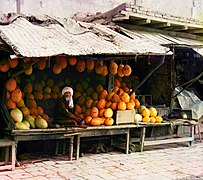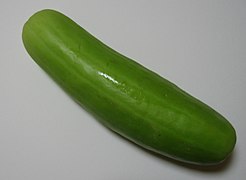Cucumis melo
| Cucumis melo | |
|---|---|

| |
| Scientific classification | |
| Kingdom: | Plantae |
| Clade: | Tracheophytes |
| Clade: | Angiosperms |
| Clade: | Eudicots |
| Clade: | Rosids |
| Order: | Cucurbitales |
| Family: | Cucurbitaceae |
| Genus: | Cucumis |
| Species: | C. melo
|
| Binomial name | |
| Cucumis melo | |
| Synonyms[1] | |
|
List
| |
Cucumis melo, also known as melon,[2][3] is a species of Cucumis that has been developed into many cultivated varieties. The fruit is a pepo. The flesh is either sweet or bland, with or without a musky aroma, and the rind can be smooth (such as honeydew), ribbed (such as European cantaloupe), wrinkled (such as casaba melon), or netted (such as muskmelon). In North America, the sweet-flesh varieties are often collectively called muskmelon, including the musky netted-rind varieties and the inodorous smooth-rind varieties,[4] and cantaloupe usually refers to the former type.[5] However, muskmelon in a narrow sense only refers to the musky netted-rind type, also known as North American cantaloupe, while the true cantaloupe is the European type with ribbed and often warty rind that is seldom grown in North America.[6]
The origin of melons is not known. Research has revealed that seeds and rootstocks were among the goods traded along the caravan routes of the Ancient World. Some botanists consider melons native to the Levant and Egypt, while others place their origin in Iran,[7] India or Central Asia.[8] Still others support an African origin, and in modern times wild melons can still be found in some African countries.[9]
Background
The melon is an
Genetics
| NCBI genome ID | 10697 |
|---|---|
| Ploidy | diploid |
| Genome size | 374.77 Mb |
| Number of chromosomes | 12 |
| Year of completion | 2012 |
Melons are
Not all varieties are sweet melons. The
Other varieties grown in Africa are bitter, cultivated for their edible seeds.[9]
For commercially grown varieties certain features like protective hard netting and firm flesh are preferred for purposes of shipping and other requirements of commercial markets.[10]
Nutrition
Per 100 gram serving, cantaloupe melons provide 34
Uses
In addition to their consumption when fresh, melons are sometimes
History
There is debate among scholars whether the abattiach in
Melon was domesticated in West Asia and over time many cultivars developed with variety in shape and sweetness. Iran, India, Uzbekistan, Afghanistan and China become centers for melon production.[9] Melons were consumed in Ancient Greece and Rome.[20]
Gallery
-
Japanese "crown melon" intended as a high-priced gift: The pictured crown melon is 6300 yen, or about US$59
-
'Squared melon' grown inAtsumi District, Aichi Japan, known as kakumero
-
The Armenian cucumber, despite the name, is actually a type of melon.
-
Melon vendor in Samarkand (between 1905 and 1915)
-
Muskmelon Seeds
See also
- Armenian cucumber - a cucumber-like variety of melon
- Bailan melon
- Barattiere – a landrace variety of melon found in Southern Italy
- Canary melon
- Carosello – a landrace variety of melon found in Southern Italy
- Crane melon
- Gaya melon
- Hami melon
- Korean melon
- Melon ball
- Melon Day
- Montreal melon
- Sugar melon
- Karit fruit
References
- ^ The Plant List: A Working List of All Plant Species, retrieved 23 January 2016
- ^ "Cucumis melo". Germplasm Resources Information Network. Agricultural Research Service, United States Department of Agriculture.
- ^ "Definition of Melon by Oxford Dictionary". Lexico Dictionaries | English. Archived from the original on June 28, 2021. Retrieved 2021-02-13.
- ^ "Definition of muskmelon". Dictionary by Merriam-Webster. Retrieved 2021-02-13.
- ^ "Definition of cantaloupe". Dictionary by Merriam-Webster. Retrieved 2021-02-13.
- ^ "Melon". Encyclopedia Britannica. Retrieved 2021-02-13.
- ISSN 1615-6110.
Melons or muskmelon are native to Iran and adjacent countries toward the west and east. In fact, 'Musk' is a Persian word for a kind of perfume and 'melon' is derived from Greek words (Robinson and Decker-Walters 1997). The origin of diversity for melon was traditionally believed to be in Africa (Robinson and Decker-Walters 1997), although recent molecular systematic studies, suggested that it may be originated from Asia and then reached to Africa (Renner et al. 2007). Central Asia, Iran, Afghanistan, India, Transcaucasia, Turkmenistan, Tajikistan, and Uzbekistan, as well as Afghanistan and China (Robinson and Decker-Walters 1997) are considered primary diversity centre for melon (Tzitzikas et al. 2009).
- ^ ISBN 9780806516158. Retrieved 26 August 2019.
- ^ ISBN 9789057821479. Retrieved 26 August 2019.
- ^ a b c Beattie, James Herbert (1951). Muskmelons. Agricultural Research Service. Retrieved 26 August 2019.
- ^ "Cucumis melo in Flora of North America". eFloras.org. Retrieved 2024-06-15.
- ^ Martin Anderson, Texas AgriLife Extension Service. "Muskmelons Originated in Persia - Archives - Aggie Horticulture". tamu.edu.
- PMID 22753475.
- ISBN 9780988474901. Retrieved 26 August 2019.
- ^ ISBN 9781579652135. Retrieved 26 August 2019.
- ^ a b "Nutrition Facts for 100 g of melons, cantaloupe, raw [includes USDA commodity food A415]". Conde Nast for the USDA National Nutrient Database, version SR-21. 2014.
- ISBN 978-0-309-10596-5. Retrieved 2008-07-17.
- ^ "We remember the fish, which we did eat in Egypt freely; the cucumbers, and the melons, and the leeks, and the onions, and the garlick" Numbers 11:5
- ISSN 1615-6110.
Melons or muskmelon are native to Iran and adjacent countries toward the west and east. In fact, 'Musk' is a Persian word for a kind of perfume and 'melon' is derived from Greek words (Robinson and Decker-Walters 1997). The origin of diversity for melon was traditionally believed to be in Africa (Robinson and Decker-Walters 1997), although recent molecular systematic studies, suggested that it may be originated from Asia and then reached to Africa (Renner et al. 2007). Central Asia, Iran, Afghanistan, India, Transcaucasia, Turkmenistan, Tajikistan, and Uzbekistan, as well as Afghanistan and China (Robinson and Decker-Walters 1997) are considered primary diversity centre for melon (Tzitzikas et al. 2009).
- ISBN 9780849389801. Retrieved 26 August 2019.
External links
- Cucumis melo L. – Purdue University, Center for New Crops & Plant Products.
- Sorting Cucumis names – Multilingual multiscript plant name database
- Cook's Thesaurus: Melons – Varietal names and pictures
- "Cucumis melo". Plants for a Future.








